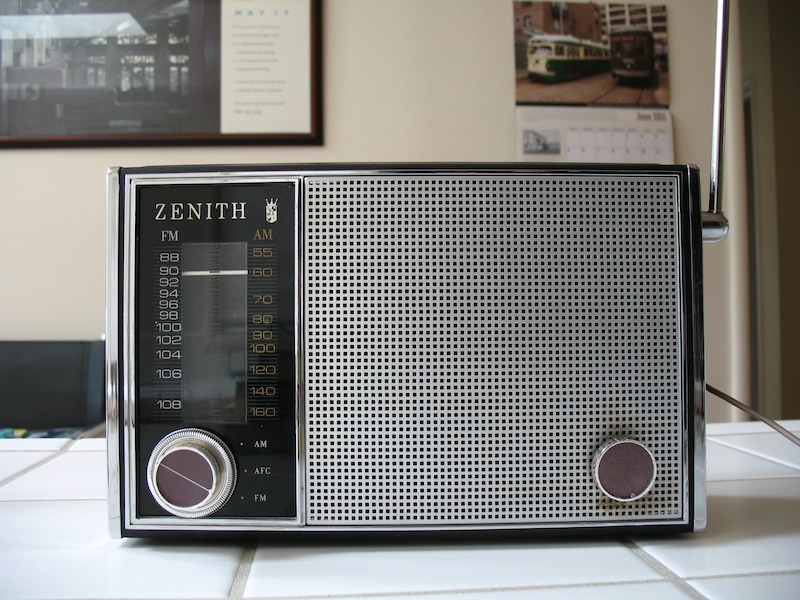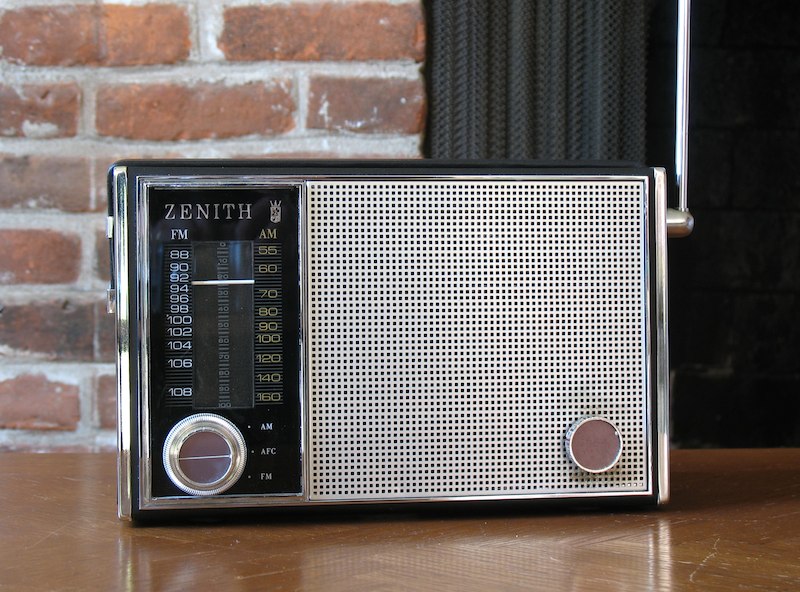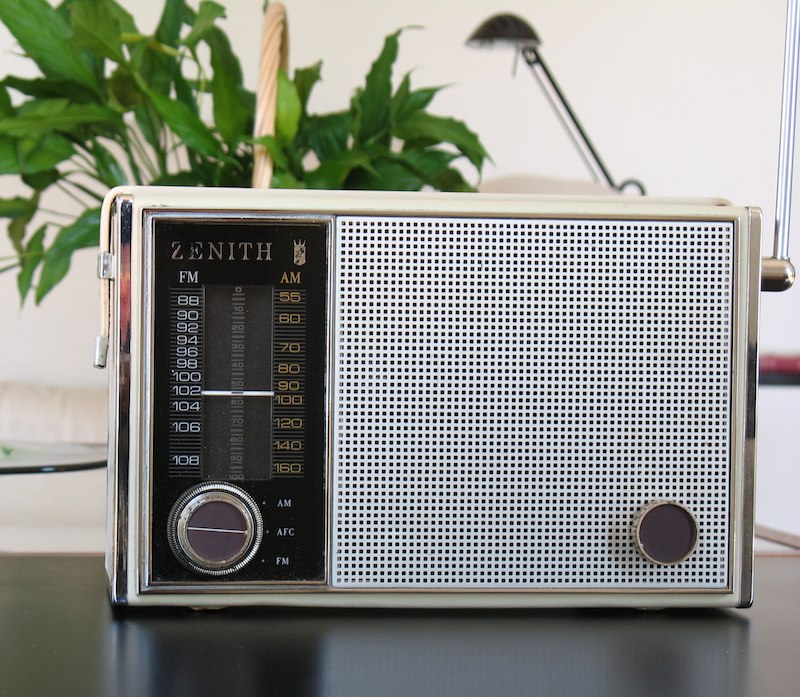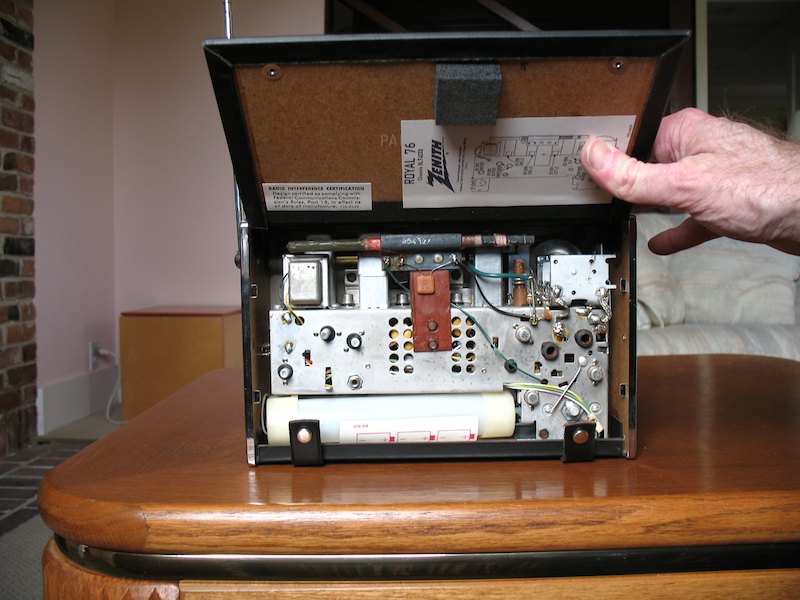
At the time this post was written, on the Fourth of July weekend in 2011, it seemed to be a good occasion to look at at the radio that was probably one of the last AM/FM portable radio models to be made in the United States: the Zenith Royal 76, also known as the Symphony.
The Symphony was first released as the Royal 820 in 1964. It was more compact than its predecessor, the Royal 880. According to Norman Smith's "Zenith Transistor Radios: Evolution of a Classic", the Royal 820 featured tuned RF stages on both AM and FM, came in one of two colors -- ivory or charcoal -- and listed for $69.95.
Smith's book stops after 1965, so it doesn't cover what could be called the Great Zenith Renumbering of 1967, in which all the three-digit Royal models were given two-digit designations, apparently assigned at random. The Royal 820 became the Royal 76. It still carried the Symphony name, though, judging by an advertisement that I found in a 1967 student newspaper from MIT. That ad listed the radio's price at $67.88, so the radio was still priced as a premium product in 1960s prices.

The radio was produced at least through 1968, but I can't find a clear indication of when it stopped production. I believe that could have happened in 1968 or 1969, as Zenith sent all its radio production to Hong Kong or other Far East locations in the 1970s.
Even in the mid-1960s, smaller and cheaper Zenith portables were made in Hong Kong, but Zenith prided itself on making premium radios in the United States at its factory in Chicago, avoiding the use of printed circuit boards, and hand-soldering discrete electronic components. In its larger radios, Zenith also employed high-performance designs for the time.
Zenith's competitors went offshore earlier, used printed circuits earlier, and often managed to produce good-performing radios, too. And they could do it for less money. So Zenith came under a lot of pressure and eventually gave up on radio manufacturing in the U.S.
Zenith hung on longer than the rest, and good performers like the Symphony were the result.

The radio's appearance is modern without being boring. The metallic speaker grill closely resembles a later classic design, the Advent 400 speaker grill.
The one big problem, as always with 1960s Zenith portable radios, is the case. Zenith didn't skimp on performance or electronic components, but it did skimp on the case. While the "Perma-Wear" fake-leather case on the Royal 76/820 isn't as bad as it was on some other Zenith models, the snaps that hold the rear door to the radio tend to break with repeated use. That door is important: it provides access to the battery container (6 "C" cells) and the headphone jack. There was also a jack, mounted on the side, for an AC adapter. Both my Royal 76s have their original adapters; it's possible the adapters were a standard accessory for the radio.
There's no tone control, but the radio's circuitry and speaker seem well-matched. You won't get deep bass and tingling treble out of the Royal 76, but you will get decently balanced sound.
The radio is an all-around good performer, on AM and FM. On AM, the radio has very good sensitivity and sound quality, though selectivity is fairly good at best. As with its other radios, Zenith made the tradeoff between sensitivity and sound quality in favor of good sound. As usual with Zenith, frequency response starts rolling off gently at 4 kHz.
On FM, it's a tough call. Why? Sensitivity is very good and image rejection is excellent. Audio levels are nearly constant despite varying signal strengths, indicating that the FM circuitry was well-designed. With moderate or weaker signals, selectivity is good. But when next to strong signals, selectivity starts degrading, even with the AFC (automatic frequency control) off. Alternate-channel selectivity, in particular, was disappointing. I really wanted to rate the FM section of this radio as very good.
I consider my Advent 400 radio to be my yardstick for whether an FM radio can be considered "very good" and, to be candid, the Royal 76's FM section is almost as good. The problem is degraded selectivity in the presence of strong signals. So I'd have to rate the Royal 76 on FM as "good", which is still a respectable performance. And note also that, in other respects, I consider it to be a very good radio.

Here's another indication that it was a good radio for its time: while many other Zenith models often had changes to their circuitry, indicated by a change in chassis numbers, it appears from my research that this didn't happen with the Royal 820/76. For example, this radio's "little brother", the Royal 810/51 ("Symphonette") had at least five versions. But all models of the Royal 820/76 have the same chassis: 9LT42Z8. As a practical matter, this means that a service manual for the Royal 820 should do equally well for the Royal 76.
Speaking of the chassis -- look the interior of the radio. There were no printed circuit boards. Everything was hand-assembled and soldered. Transistors were inserted into plug-in sockets. Note also the headphone jack on the metal chassis, and the separate case for holding 6 "C" cells. This radio was clearly meant to last.
It's also notable that the model number or the term "Symphony" never appeared on the front of the radio. The only indication is in the interior, with the paper label that shows the chassis number and a basic schematic showing transistor placement.
To summarize, the Symphony is a well-designed, handsome radio with well-rounded performance. It's not exceptional, but it is good or very good in many aspects. I consider it to be one of Zenith's best portable radios. It really shows what Zenith could do, and what quality-minded American manufacturers could do.